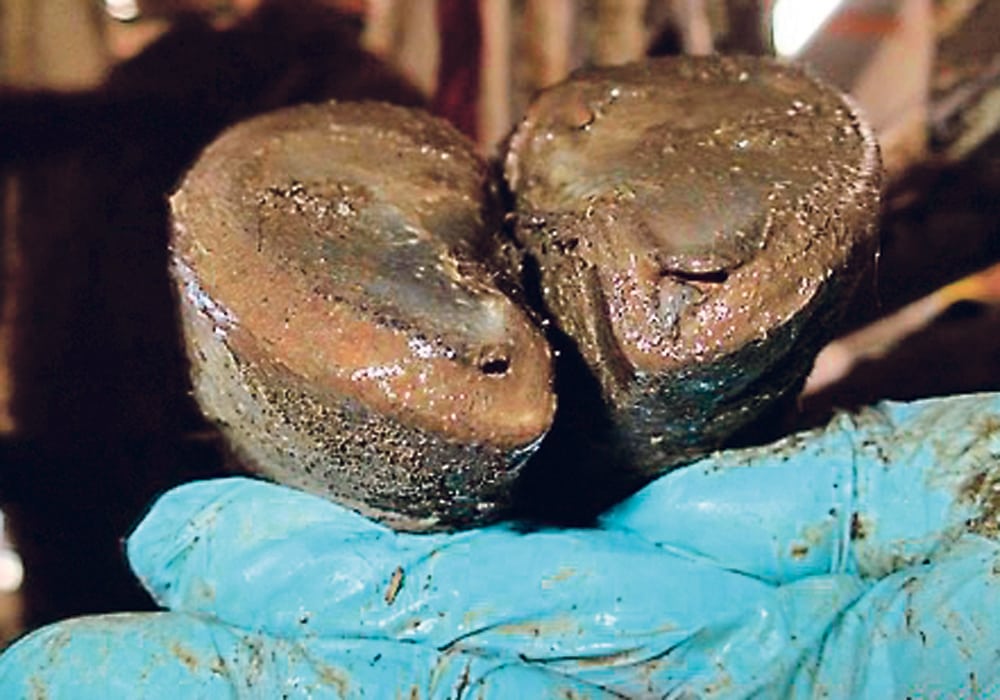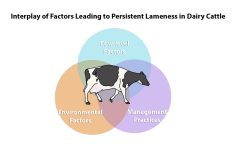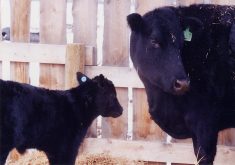Toe tip necrosis syndrome (TTNS), a disease that causes lameness in the hind feet of cattle, has been overlooked for years said a veterinary researcher.
“I think the disease has always been there and we’ve just misdiagnosed it,” said Murray Jelinski from the Western College of Veterinary Medicine at the University of Saskatchewan in Saskatoon.
“It’s probably much, much more common than we previously appreciated. It’s like many things in veterinarian and human health. The more you look, the more you find,” said Jelinski, who is also the college’s Alberta chair in beef cattle health and production medicine.
Read Also

BinSentry sensors reduce feed-bin outages
BinSentry sensors mean fewer feed bin outages and more efficient deliver for feed mills.
About six years ago, Jelinski and other researchers started delving deeper into toe abscesses that appear in the hind hoofs of feedlot cattle.
They found that the disease occurs somewhat infrequently but tends to cluster sporadically, which makes it difficult to investigate.
“So you might have a feedlot with 20,000 animals and you hardly see a case, but then all of a sudden you’ll have one pen where they’ll be 20 or 30 or 40 cases out of 200 to 300 animals. So that would be an extreme, but that’s been reported,” he said.
He said probably 90 per cent of cattle pens won’t have the disease, then suddenly a cluster breaks out because the disease had previously been improperly diagnosed.
About half of cattle identified with toe tip necrosis will likely be euthanized. The other half should be good to sell.
“That’s a really crude estimate because we don’t have a good, clear idea on how many come around (recover).”
Toe tip necrosis syndrome, also called toe abscesses, or P3 necrosis, develops when the hind hoofs of cattle become worn down and separation occurs in the white line juncture between the sole and hoof wall. When the white line separates, bacteria can penetrate into the hoof and cause infection in the bony toe tip, also known as the third phalangeal or P3.
Beneath the hoof wall is the dermis that contains blood and nerves. When inflammation occurs within the hard hoof wall, pressure builds making it painful for animals to walk.
“These cattle come into the feedlot and within a day or the first month or so is when the disease generally occurs. They develop a lameness in one or both hind legs.”
The disease is rarely seen in front legs, and is most often confined to one hind leg, Jelinski added.
Feedlot monitors have a difficult time telling it from foot rot or an injury because there usually is no swelling.
Time shortage is the main reason why TTNS continues to be under-diagnosed, especially during the busy feedlot season when pen checkers are quickly identifying lame animals and those with pneumonia.
“To really make a good diagnosis, you’ve got to stop, lift up the foot, clean it all off and have a really close look at the white line,” he said.
“It’s probably not going to change a lot of what they’re going to do with that animal on that day. The problem with the misdiagnosis though is that if you continue to say, I don’t see toe tip necrosis in my feedlot, then you’re probably missing the opportunity to correct it.”
Jelinski has confirmed that, after dissecting hundreds of hoof samples from feedlot cattle that had died of TTNS, on average 21 per cent of infected hoof walls were thinner than hoof walls in non-infected feet.
From this evidence, the abrasion theory was developed.
“Most people would now appreciate what’s happening is these cattle are coming into the feedlots or in the auction mart, wherever they’re being handled, probably being run across concrete floors or abrasive surfaces.
“When they get pushing and shoving, their back legs will slip on the floor and it just kind of wears those toes down.
“And if you’ve been around cattle being handled in chutes and they’re really agitated, you almost smell that hoof material burning.
“My belief is that it probably happens in some animals within seconds.”
He said researchers are starting to believe that high-strung cattle are more prone to the disease.
Once out of the chute and the concrete floors of processing areas, the hoof is further compromised and aggravated at the weak juncture (white line).
Jelinski was surprised and curious when several dissections revealed bits of straw and other organic material embedded inside the white line layer of the foot.
“How does that possibly get in that foot because the foot looks like it’s fully enclosed, like a normal foot? And that’s when it occurred to me that straw is getting in when they’re walking,” he said.
“That’s an important part of the disease because when we went and cultured the bacteria within that foot, we find common contaminants that you would expect to see in a feedlot, of fecal contamination, E. coli, streptococcus, staphylococcus and other bacteria called trueperella.”
“We’ve been able to show that the animals come in, they’re wearing their sole down, they’re breaking that white line down and then gaping open and every time they step, they’re impacting the bacterial laden manure and organic material into that. When that closes down, it’s the perfect environment for bacteria to grow. There’s body heat there, there’s blood, there’s all the perfect media for bacteria to grow.”
Antibiotics have minimal effect because the P3 bone is not well vascularized with no bone marrow cavity and minimal blood supply.
Next, the bacterial infection travels up the leg causing tendonitis in the tendons and myositis in the muscles.
Once in the bloodstream, the bacteria can cause abscesses in lungs, liver and kidneys, which can eventually kill the animal.
Jelinski said abscesses in the lungs can fool veterinarians during post-mortems into thinking the animal died of embolic pneumonia.
But as more knowledge about TTNS is shared, veterinarians who find those things during a necropsy are more likely to check the toes. They can use toe nippers to nip the ends of the toes and then can see where the white line is separated. It’s often black and might contain puss, or it could contain dark, crusted material, he said.
In some instances, preventive measures taken by feedlots can make footing worse.
“Lots of producers have used basically welded rebars and a grid pattern to help the animals get traction, which makes sense, but it’s also probably a double-edge sword that can also be too aggressive on them,” he said.
“You need to have certain amount of traction versus you can’t have too much abrasiveness.”
Ongoing research is studying how to decrease the disease prevalence by comparing different types of flooring design and material to evaluate possible alternatives.














